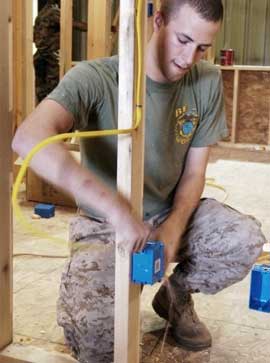JANUARY 9, 2018
BY B. DAVID ZARLEY
Laura Asher may be the tallest thing for miles.
Asher had climbed multiple ladders, lightly struck her helmeted head on a protruding hose, maneuvered through a small, greased aperture, and taken a seat at the controls of a luffing tower crane, roughly 80 feet above Illinois. She was far enough south that the skyscrapers of Chicago had given way to flat former prairie which seems to run, flush and forever.
The crane and its canary compatriots tower above the landscape, rivaled only by the wind turbine trainer and the stacks of shipping containers across a large pond from the William E. Dugan Training Center, where the Local 150 of the International Union of Operating Engineers trains apprentices and journeymen.
…
Asher’s father was an operating engineer, a member of the union, and he suggested she look into joining. With help from Helmets to Hardhats, a nonprofit that connects veterans with job training in the construction sector, Asher put in her application and was accepted to Local 150’s training program. The application cost $25 in processing fees and the training is free.
Millions of post-9/11 veterans like Asher-including those who served in Afghanistan, Iraq, against ISIS, and in the myriad other actions which constitute the War on Terror-have come home and transitioned from military to civilian life. While women made up a mere 4 percent of the veterans from the World War II, Korean War and Vietnam eras, the veterans from the second Gulf War and onward are 18 percent female, according to a Bureau of Labor Statistics report released in March 2017. Both male and female veterans’ unemployment rates hover around the 5 percent mark.
The study also found that in 2016, Gulf War-era II veterans, as they’re called, were unemployed at a rate similar to their non-veteran peers with one exception: men aged 25-35, whose unemployment rate was 6.6 percent compared to 4.9 percent for non-veterans. Veterans were also far more likely to work in the public sector than non-veterans, especially for the federal government.
This massive pool of workers is especially appealing to the skilled labor unions. Currently, Asher can be seen on televisions around the region in a commercial enticing veterans to train with the Local 150. Helmets to Hardhats, the trade union-sponsored nonprofit that connects veterans and soon-to-be veterans with job programs in the construction sector, was borne out of unions’ recruitment efforts.
“The veterans are coming from all over the nation and coming home,” said Robert Schwartz, senior program manager of Helmets to Hardhats. “So how do we reach out to them and let them know about these opportunities that we have for them for their next career?”
For the unions, veterans bring valuable benefits as a labor pool, both tangible and intangible.

